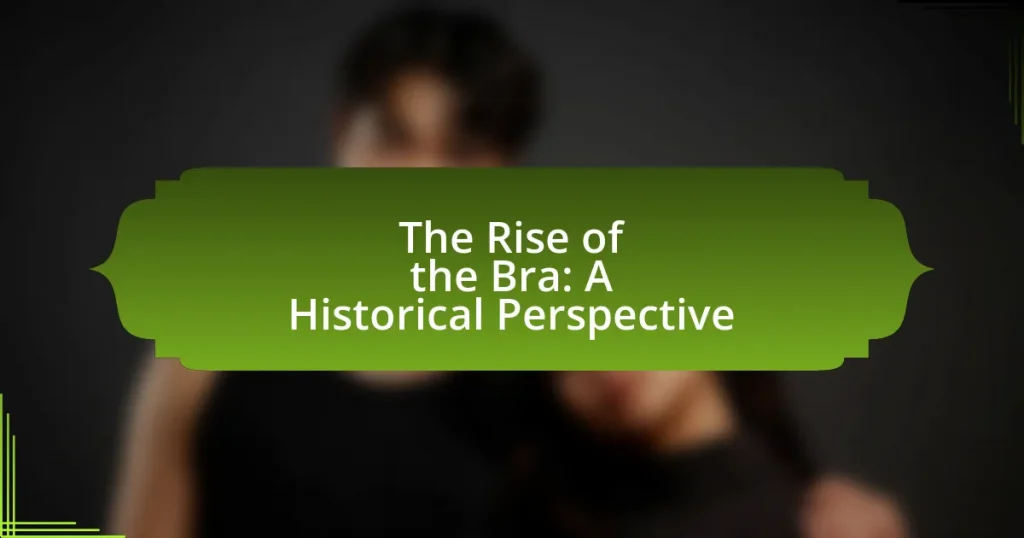The article explores the intricate relationship between lingerie and feminism, highlighting how lingerie has transitioned from a symbol of oppression to one of empowerment and self-expression for women. It examines the historical evolution of lingerie, particularly during the feminist movements of the 1960s and 1970s, which challenged restrictive garments and promoted body positivity. Key milestones in this evolution are discussed, including the impact of modern brands that prioritize inclusivity and ethical practices, as well as the role of social media in reshaping perceptions of lingerie. The article also addresses contemporary challenges women face regarding body image and societal expectations, while offering practical tips for embracing lingerie as a symbol of empowerment.

What is the relationship between lingerie and feminism?
The relationship between lingerie and feminism is complex, as lingerie has been both a symbol of female empowerment and a subject of feminist critique. Feminism advocates for women’s autonomy and self-expression, which lingerie can represent when women choose to wear it for their own pleasure and confidence. Conversely, lingerie has also been critiqued for perpetuating objectification and unrealistic beauty standards, which can undermine feminist ideals. Historical movements, such as the feminist push in the 1960s against restrictive garments, illustrate how lingerie has evolved from a tool of oppression to one of liberation, reflecting women’s changing roles in society.
How has lingerie evolved as a symbol of women’s liberation?
Lingerie has evolved into a symbol of women’s liberation by transitioning from restrictive garments to expressions of personal empowerment and choice. Historically, lingerie was designed primarily for male pleasure and societal expectations, exemplified by corsets in the 19th century that constrained women’s bodies. The feminist movements of the 1960s and 1970s challenged these norms, advocating for women’s autonomy over their bodies and choices, which led to the introduction of more comfortable and diverse lingerie options.
By the late 20th century, brands began to embrace body positivity and inclusivity, reflecting a broader cultural shift towards celebrating women’s individuality. This evolution is evidenced by the rise of campaigns promoting diverse body types and the rejection of traditional beauty standards, such as the “Real Beauty” campaign by Dove in 2004. Today, lingerie serves not only as a functional garment but also as a statement of self-expression and empowerment, illustrating women’s liberation from societal constraints.
What historical events contributed to the association of lingerie with feminism?
The association of lingerie with feminism was significantly influenced by the women’s liberation movement of the 1960s and 1970s, which challenged traditional gender roles and advocated for women’s rights. This period saw the rise of protests against restrictive clothing, including the famous 1968 Miss America protest where bras were symbolically discarded, representing a rejection of societal expectations regarding women’s bodies. Additionally, the introduction of more functional and diverse lingerie styles allowed women to express their individuality and autonomy, further intertwining lingerie with feminist ideals. The feminist critique of the male gaze also reframed lingerie as a tool for empowerment rather than objectification, solidifying its role in feminist discourse.
How do cultural perceptions of lingerie reflect feminist ideals?
Cultural perceptions of lingerie reflect feminist ideals by showcasing the empowerment of women through choice and body autonomy. Feminism advocates for women’s rights to express their sexuality and individuality, which is evident in the evolving designs and marketing of lingerie that cater to diverse body types and preferences. For instance, the rise of brands promoting inclusivity and body positivity, such as Savage X Fenty, emphasizes that lingerie is not merely an object of male gaze but a means for women to celebrate their bodies. This shift aligns with feminist ideals by challenging traditional norms and encouraging women to reclaim their narratives around femininity and sexuality.
Why is lingerie considered a form of self-expression for women?
Lingerie is considered a form of self-expression for women because it allows them to convey their individuality, confidence, and personal style. This intimate apparel serves as a canvas for women to showcase their preferences, whether through color, design, or fabric, reflecting their mood and identity. Historically, lingerie has evolved from being merely functional to embodying empowerment, as seen in the feminist movements of the 20th century, where women began to embrace lingerie as a symbol of autonomy and self-ownership. This shift is supported by studies indicating that wearing lingerie that aligns with personal taste can enhance self-esteem and body image, reinforcing the idea that lingerie is not just about aesthetics but also about personal empowerment and expression.
What role does lingerie play in body positivity movements?
Lingerie plays a significant role in body positivity movements by promoting self-acceptance and challenging societal beauty standards. The inclusion of diverse body types in lingerie advertising and design empowers individuals to embrace their bodies, fostering a sense of confidence and worth. Research indicates that brands that feature models of various sizes and shapes contribute to a more inclusive narrative, which can positively impact consumers’ body image. For instance, studies have shown that exposure to body-positive imagery can reduce body dissatisfaction and improve self-esteem among women. Thus, lingerie serves not only as a garment but also as a tool for advocacy in the body positivity movement.
How do different styles of lingerie empower women in various ways?
Different styles of lingerie empower women by enhancing body confidence, promoting self-expression, and challenging societal norms. For instance, lingerie that emphasizes comfort and fit allows women to feel more at ease in their own skin, which can lead to increased self-esteem. Additionally, styles such as lace, bold colors, or unique designs enable women to express their individuality and personal style, reinforcing the idea that femininity can be diverse and multifaceted. Furthermore, the evolution of lingerie from purely functional to a symbol of empowerment reflects a shift in societal attitudes, where women reclaim their sexuality and agency. This transformation is supported by the rise of brands that prioritize inclusivity and body positivity, demonstrating that lingerie can serve as a tool for liberation rather than oppression.

What are the key milestones in the history of lingerie and feminism?
Key milestones in the history of lingerie and feminism include the introduction of the corset in the 19th century, which symbolized women’s oppression, and the subsequent feminist movements that challenged these restrictive garments. The 1920s saw the flapper movement, where women began to embrace more comfortable and liberating undergarments, marking a shift towards body positivity. In the 1960s, the feminist movement further advanced lingerie as a symbol of empowerment, with the rejection of traditional norms and the introduction of the bra-burning protests. The 1980s and 1990s brought a focus on lingerie as a form of self-expression and sexuality, with brands like Victoria’s Secret promoting a new image of femininity. These milestones illustrate how lingerie has evolved from a symbol of oppression to one of liberation and empowerment for women.
How did the suffragette movement influence lingerie design?
The suffragette movement significantly influenced lingerie design by promoting the idea of women’s liberation and comfort over restrictive garments. As suffragettes advocated for women’s rights, including the right to vote, they also challenged traditional gender norms, which extended to clothing choices. This led to a shift in lingerie design, moving away from corsets that constrained women’s bodies to more practical and comfortable undergarments. The introduction of lighter fabrics and less restrictive styles reflected the suffragettes’ desire for freedom and autonomy, aligning with their broader goals of empowerment and equality. Historical evidence shows that during the late 19th and early 20th centuries, as women gained more rights, lingerie became a symbol of their evolving identity, emphasizing both functionality and femininity.
What changes in lingerie styles occurred during the feminist movements of the 1960s and 1970s?
During the feminist movements of the 1960s and 1970s, lingerie styles shifted significantly towards comfort and practicality, moving away from traditional, restrictive designs. This period saw the rise of more functional undergarments, such as bralettes and boyshorts, which emphasized body positivity and personal choice over the previously dominant, often uncomfortable styles like corsets and padded bras. The feminist ideology promoted the idea that women should not be confined by societal expectations regarding their bodies, leading to a rejection of lingerie that was primarily designed for male gaze. This transformation was reflected in popular culture, where brands began to market lingerie that celebrated women’s autonomy and comfort, aligning with the broader goals of the feminist movement for liberation and equality.
How did the introduction of new materials and technologies impact women’s lingerie choices?
The introduction of new materials and technologies significantly expanded women’s lingerie choices by enhancing comfort, fit, and design versatility. Innovations such as elastic fabrics, breathable synthetics, and seamless construction allowed for a wider range of styles that catered to diverse body types and preferences. For instance, the development of Lycra in the 1960s revolutionized lingerie by providing stretch and support, leading to the popularity of form-fitting designs. Additionally, advancements in manufacturing techniques enabled mass production, making lingerie more accessible and affordable for women. This shift not only reflected changing societal norms around femininity and body image but also empowered women to express their individuality through their lingerie choices.
What role do modern lingerie brands play in feminist discourse?
Modern lingerie brands play a significant role in feminist discourse by promoting body positivity and challenging traditional beauty standards. These brands often feature diverse models of various sizes, ethnicities, and gender identities, which helps to foster inclusivity and empower individuals to embrace their bodies. For instance, brands like Savage X Fenty have been praised for their commitment to diversity, showcasing a wide range of body types in their campaigns, which aligns with feminist ideals of representation and self-acceptance. Additionally, many modern lingerie brands engage in conversations about consent and sexual empowerment, further integrating feminist principles into their marketing and product offerings. This shift not only reflects changing societal attitudes but also encourages consumers to rethink their relationship with lingerie as a tool for self-expression rather than merely an object of desire.
How are brands using inclusive marketing to promote body diversity?
Brands are using inclusive marketing to promote body diversity by featuring models of various body types, sizes, and ethnicities in their advertising campaigns. This approach not only reflects a broader range of consumer identities but also challenges traditional beauty standards. For instance, brands like Aerie and Savage X Fenty have gained recognition for their commitment to body positivity by showcasing unretouched images and diverse body shapes, which resonate with a wider audience. Research indicates that 67% of consumers prefer brands that represent diversity in their marketing, highlighting the effectiveness of inclusive strategies in fostering brand loyalty and engagement.
What initiatives are lingerie companies taking to support women’s rights?
Lingerie companies are increasingly implementing initiatives to support women’s rights by promoting body positivity, inclusivity, and ethical production practices. For instance, brands like Aerie have launched campaigns that feature unretouched images of diverse body types, aiming to challenge traditional beauty standards and empower women. Additionally, companies such as ThirdLove donate a portion of their profits to organizations that advocate for women’s health and rights, reinforcing their commitment to social causes. Furthermore, many lingerie brands are adopting sustainable practices that prioritize fair labor conditions, thereby supporting women’s rights in the workforce. These initiatives reflect a broader movement within the lingerie industry to align business practices with the empowerment and rights of women.

How does lingerie intersect with contemporary feminist issues?
Lingerie intersects with contemporary feminist issues by serving as a site of empowerment and body positivity, challenging traditional norms of femininity and sexuality. Feminists advocate for the right to choose how to express one’s identity through lingerie, emphasizing autonomy over one’s body and rejecting societal pressures that dictate how women should dress. This perspective is supported by movements that promote diverse representations of women in lingerie advertising, aiming to dismantle the narrow beauty standards often perpetuated in the fashion industry. Additionally, the rise of brands that prioritize inclusivity and ethical production aligns with feminist values, reinforcing the idea that lingerie can be both a personal choice and a political statement.
What challenges do women face regarding lingerie in today’s society?
Women face several challenges regarding lingerie in today’s society, including issues of body image, sizing inconsistencies, and societal expectations. Body image concerns are prevalent, as many women feel pressured to conform to unrealistic beauty standards perpetuated by media and advertising, leading to dissatisfaction with their lingerie choices. Sizing inconsistencies across brands create difficulties in finding well-fitting lingerie, as studies indicate that up to 80% of women wear the wrong bra size, which can affect comfort and confidence. Additionally, societal expectations often dictate that lingerie should be both aesthetically pleasing and functional, creating a conflict between personal preference and external pressures. These challenges highlight the complex relationship women have with lingerie in the context of empowerment and self-expression.
How does the lingerie industry address issues of consent and autonomy?
The lingerie industry addresses issues of consent and autonomy by promoting body positivity and empowering individuals to make choices about their own bodies. Many brands now emphasize the importance of consent in marketing campaigns, showcasing diverse body types and encouraging consumers to embrace their personal preferences without societal pressure. For instance, campaigns like Aerie’s #AerieREAL focus on unretouched images and celebrate authenticity, which aligns with the principles of autonomy and self-acceptance. Additionally, some companies have implemented ethical practices, ensuring that their products are made with consent from workers and that consumers are informed about the sourcing and production processes. This shift towards transparency and empowerment reflects a broader cultural movement that values individual choice and respects personal boundaries in the context of lingerie.
What impact does social media have on the perception of lingerie and feminism?
Social media significantly influences the perception of lingerie and feminism by promoting body positivity and challenging traditional beauty standards. Platforms like Instagram and TikTok allow diverse representations of lingerie, showcasing various body types and encouraging self-expression. This shift has led to a broader acceptance of lingerie as a symbol of empowerment rather than objectification. For instance, campaigns by brands such as Aerie and Savage X Fenty emphasize inclusivity and celebrate individuality, aligning lingerie with feminist ideals of autonomy and self-love. Research indicates that social media campaigns can enhance women’s self-esteem and body image, reinforcing the connection between lingerie and feminist empowerment.
How can women navigate the lingerie market to align with feminist values?
Women can navigate the lingerie market to align with feminist values by prioritizing brands that promote body positivity, ethical production, and inclusivity. Many lingerie companies now focus on diverse sizing, sustainable materials, and fair labor practices, which resonate with feminist principles. For instance, brands like ThirdLove and Aerie have made commitments to inclusivity and body diversity, offering a wide range of sizes and showcasing models of various body types. Additionally, supporting companies that advocate for women’s rights and donate to relevant causes can further align purchasing decisions with feminist values. Research indicates that consumer awareness of ethical practices influences purchasing behavior, with 66% of global consumers willing to pay more for sustainable brands, highlighting the impact of informed choices in the lingerie market.
What should women consider when choosing lingerie brands that support feminist principles?
Women should consider the ethical practices, inclusivity, and body positivity of lingerie brands that support feminist principles. Ethical practices include fair labor conditions and sustainable sourcing, which align with feminist values of social justice and environmental responsibility. Inclusivity refers to brands that offer a diverse range of sizes and styles, catering to all body types, thereby promoting body positivity and self-acceptance. Brands that actively support women’s rights initiatives or donate to feminist causes further reinforce their commitment to feminist principles. For example, brands like ThirdLove and Aerie have been recognized for their inclusive sizing and body-positive marketing campaigns, demonstrating a tangible commitment to these values.
How can women advocate for more ethical practices within the lingerie industry?
Women can advocate for more ethical practices within the lingerie industry by supporting brands that prioritize sustainability, fair labor practices, and transparency in their supply chains. By choosing to purchase from companies that are certified by organizations like Fair Trade or those that disclose their sourcing and manufacturing processes, women can drive demand for ethical products. Research indicates that the global ethical fashion market is projected to reach $8.25 billion by 2023, highlighting a growing consumer preference for responsible practices. Additionally, women can engage in activism by participating in campaigns that raise awareness about unethical practices, such as sweatshop labor and environmental degradation, thereby influencing public opinion and encouraging brands to adopt more ethical standards.
What practical tips can women use to embrace lingerie as a symbol of empowerment?
Women can embrace lingerie as a symbol of empowerment by selecting pieces that reflect their personal style and comfort, thereby enhancing their confidence. Choosing lingerie that fits well and makes them feel good can significantly boost self-esteem, as studies show that wearing clothing that aligns with one’s identity can positively affect mood and self-perception. Additionally, women can explore various styles, colors, and fabrics to express their individuality, reinforcing the idea that lingerie is not just functional but also a form of self-expression. Engaging in discussions about body positivity and challenging societal norms around beauty can further empower women to view lingerie as a celebration of their bodies, rather than a tool for objectification.



